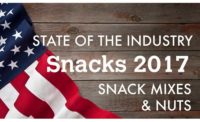In the three long years after the start of the pandemic, the snack industry changed but persevered. Some on-the-go snacking gave way to snacking with family at home, and “social snacking” occasions, like watching a game on TV or having friends over for dinner, diminished.
As we try to put the pandemic in the rearview, on-the-go and shared snacking occasions are back— some would say more vibrant than ever.
We talked to David Walsh, vice president of membership and communications with SNAC International, for an overview of the snack industry, including what has changed and what has remained the same over the past year.
Liz Parker: Can you share a brief overview of the past year in snacks? What were some of the common threads running through the industry in 2022?
David Walsh: According to Circana, 49% of consumers snack 3+ per day, which is up four points in the last two years. For those that snack 3+ times per day, the biggest upticks are in the morning and late evening. Embedded in these large numbers I see many common threads, which is also an indicator of snacking’s durability.
Snacking has exploded the last 10 years or so, but it took a different form during COVID, when consumers were spent more time at home. Snacking provided nutrition but it was also an affordable indulgence—it brought a sense of fun, it was a way to connect emotionally and culturally through food. As we move past COVID, I see trends reverting to our pre-COVID trends norms, which include more on-the-go eating occasions and using snacks as meal replacement. As always, this industry has responded to this shift with innovation and a burgeoning of options packing a nutritional punch, like protein, vitamins, and minerals.
Flavor experimentation and snacking simply for fun continues to be a huge driver of the category. As some of the supply chain strains of 2021–2022 ease up, we’re starting to see new products, ingredients, cooking methods, and very adventurous bold flavors hit the shelves once again.
Getting into consumer preferences—super-hot and spicy paired with sweet flavors remains as popular as ever. We’re also seeing hot flavors with added nuance—different types of peppers, like ghost pepper, habanero, hints of lime, chile, chipotle adobo, hot flavors paired with cheese flavors are all gaining steam. Sweet flavors are also becoming more popular in snacking—things like fruit, chocolate, maple, nut butters. Finally, international flavors, like Latin American, Asian, and Middle Eastern are all becoming more popular, which speaks again to the desire for adventure.
Depending on the consumer, their age, where they live, their mood, the time of day— consumers could be looking for healthy, spicy, hand-held, a snack to augment a sandwich. One customer may be looking for more of a traditional, indulgent snack from a brand they know and love, or they may look to go outside their comfort zone to sample a new ingredient or get adventurous with a new flavor. There’s a growing subset of snackers that are treating the category as a place where they can add value to their diet. Benefits like pro- and prebiotics to promote digestive health, and ingredients that promote immune health, like ashwagandha.
A big story about snacking today is this one of holistic health and holistic snacking. Consumers choose snacks with many factors in mind, all of which amount to their own sense of holistic health. This could refer to their own nutritional goals, their mental health, or the health of the planet. Taste continues to and will always dominate this category, but holistic health is becoming more important.
Regarding mini-meals: according to Circana, 50% of consumers often eat snacks instead of a meal because they are on the go; this is an increase of 6 points from two years ago. From my view, this trend plays out in categories like meat snacks, snack bars, and paired offerings like packaged meats, cheeses, and nuts.
Not immune to inflation: Snacks and snack-adjacent categories made up 27% of food and beverage sales in 2022. As inflation took hold in the last year, consumers have stretched their dollars more, and have gravitated toward satiating options like snacks with protein (and especially snacks with an additional protein punch).
LP: What were some of the biggest challenges producers had to wrangle with, and some of the most pressing issues?
DW: SNAC International just held its annual Legislative Summit in Washington, DC, where members came to the nation’s capital to advocate for the industry. SNAC facilitated meetings with members of Congress to discuss our advocacy priorities.
One of the challenges our members continue to grapple with involves workforce and labor shortages. The economic pressure points on the food industry brought on by COVID and the conflict in Ukraine are exacerbated by the lack of a legal workforce, which stems from a decrease in legal migration to the U.S. The U.S. labor pool is set to grow just 0.2% per year between 2024 and 2031, according to the Congressional Budget Office, and 9.5 million jobs are available across all sectors, according to the U.S. Bureau of Labor Statistics. SNAC members have asked Congress to work hard to reform immigration in a way that prioritizes America’s workforce needs.
Related to labor, transportation strains continue to pose challenges for our industry. There’s a current shortage in the U.S. of 78,000 truck drivers, while more than 80% of our communities get their goods exclusively by trucks. With the truck driving population aging out, SNAC supports two pieces of legislation seeking to attract new truck drivers: the Safer Highways and Increased Performance for Interstate Trucking (SHIP IT) Act (H.R. 471), and the DRIVE Safe Integrity Act (H.R. 3408).
An additional priority issue for SNAC and its members relates to FDA’s Nutrition Innovation Strategy, which includes numerous priorities ranging from reducing sodium to educating consumers on the updated nutrition facts panel. In October 2021, FDA finalized voluntary short-term sodium target guidance for certain foods and is committed to publishing long-term targets in the future. Our members have had to review products and, in some cases, reformulate to meet the short-term sodium reduction targets. As FDA considers longer-term sodium reduction targets. SNAC shares the FDA’s goal of reducing sodium consumption among the general population to improve public health and is committed to continuing to work with FDA to develop strategies for reducing sodium in snack foods in a manner that will be both acceptable and enjoyable for consumers.
LP: How have producers risen to the various challenges encountered through the past year?
DW: While supply chain issues have improved recently, long-term labor shortages and other issues that accelerated during the pandemic have challenged logistics and delivery of food, ingredients, and supplies in general. The rise in costs and delays compared to pre-pandemic have created obstacles for the entire industry, but our members have responded out of necessity to continue producing and delivering the foods consumers love. Investments in technology and improved efficiency have helped ease expenses and increase velocity. Logistics and transportation companies have had to increase their drivers’ pay to ensure better retention. During SNAC International’s panel discussion on supply chain and logistics at our 2022 Executive Leadership Forum, the panelists concluded that new problem-solving managers, better use of information technology, and thinking outside the box are all effective tools in alleviating supply chain delays and rising costs.
LP: How do you think the landscape might be shifting for the snack industry? What challenges and opportunities does the year hold for snack pros?
DW: There are endless trends and consumer preferences to stay on top of, so producers and retailers need to make sure their product offerings and product diversification is appropriate for the types of consumers they’re trying to appeal to. Most retail channels would like to offer a mix of functional, better-for-you, and traditional snacks so they have something that can appeal to anyone: dieters, on-the-go meal replacers, adventure seekers, and of course, indulgers. There are plenty of opportunities for snack producers to fill these needs.
Additionally, consumers are more in-tune than ever with the environmental consequences of their daily activities, making sustainable sourcing, packaging, and transportation critically important. Beginning in 2021, SNAC launched a conscientious effort to bring subject matter experts to educate, inform, and prompt discussion around sustainable supply chains. Since then, we’ve brought in 31 speakers and launched a Recycling Task Force. We encourage all in the industry to engage with our programming and leadership on sustainability so that you can review and establish your own strategies for operating in a sustainable and efficient manner.




